In the 1820's and 1830's, the one day wooden movement shelf clock, such as the pillar and scroll and the bronze looking glass, was in mass production. The market grew rapidly and competition became severe. An economic recession in 1837 brought the clock business almost to a halt. Chauncey Jerome wrote:
"At Richmond I was looking after our old accounts, settling up, collecting notes and picking up some scattered clocks."
"One night I took one of these clocks into my room and placing it in the table, left a light burning near it and went to bed. While thinking over my business troubles and disappointments, I could not help feeling very much depressed. I said to myself I will not give up yet, I know more about the clock business than anything else. That minute I was looking at the wood clock on the table and it came into my mind instantly that there could be a cheap one day brass clock that could take the place of the wood clock. I at once began to figure on it; the case would cost no more, the dials, glass, and weights and other fixtures would be the same, and the size could be reduced. I lay awake nearly all night thinking this new thing over. I knew there was a fortune in it."
"I arrived home from the south on the 28th of January (1838), and told my brother who was a first rate clockmaker what I had been thinking about since I had been gone. He was much pleased with my plan, thought it a first rate idea, and said he would go right to work and get up the movement, which he perfected in a short time so that it was the best clock that had ever been made in this or any other country. There have been more of this same kind manufactured than of any other in the United States."*
Noble Jerome received patent number 1200 for his clock movement, issued June 27, 1839. The new clock proved to be a great success, and so Seth Thomas decided to enter the market.
"In 1840, Thomas sent his nephew, Marcus Prince, over to Bristol to learn how Chauncey Jerome was making the cheap 30 hour brass clock. Hiram Camp, Jerome's foreman wrote, "about the year 1840, I think, Seth Thomas, who had not as yet engaged in the making of brass clocks, sent one of his men, a Mr. Prince, over to Bristol to work for Mr. Jerome and learn how to do the work. Mr. Jerome said to his foreman, Mr. Camp, 'Now Mr. Thomas is a good man and he wants to get into making brass movements and I want you to teach Mr. Prince all that you can about the work.' So, after two or three years, Mr. Prince went back to Mr. Thomas, and he began to make the brass movements.".... "
"Prince returned to Plymouth Hollow and made the first brass clock movements in 1842. In 1844 or 1845 wood movements were phased out and Prince assumed entire control of movement manufacture for Thomas. These earliest brass clocks were probably all in ogee cases with the addition of 30 hour and 8 day cases with columns about 1850."**
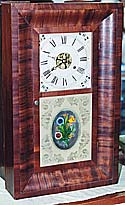
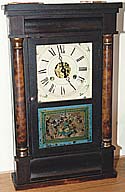
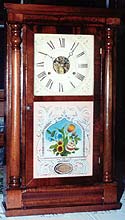
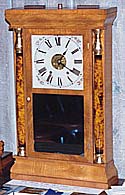
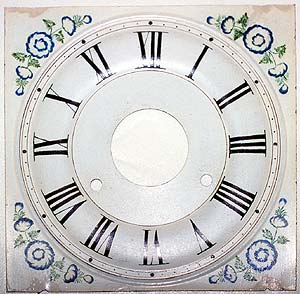
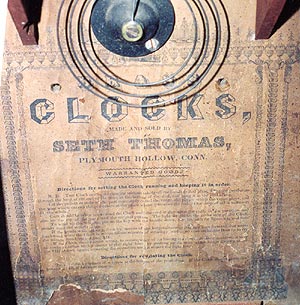
Ogee case, made in Plymouth Hollow, glasses puttied in. Height 25 31/32", width 15 5/8", depth 4 3/8" plus veneer thickness.
Dial: metal, two rings drawn around time track, dots for minute marks.
Early features of dial: tapered numerals 3, 4 and 8, small winding holes (8.2 mm).
Label: printed by Elihu Geer, Hartford, Connecticut, no address given. This dates it to 1842 - 1845.
Movement: type 1.243 (the earliest type).
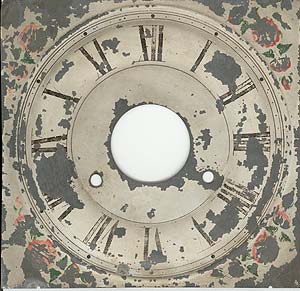
Dial: metal, two rings drawn around time track, dots for minute marks.
Early features of dial: tapered numerals 3, 4 and 8, small winding holes (8.2 mm).
This dial was purchased with its original Seth Thomas movement at a flea market.
Movement: type 1.243 (the earliest type).
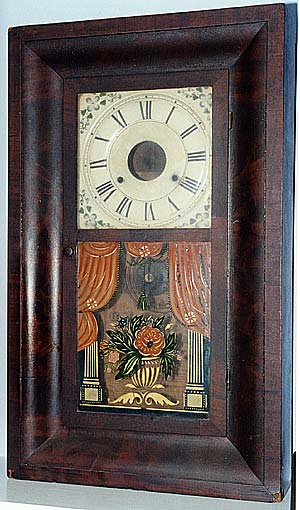
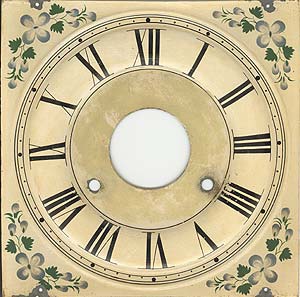
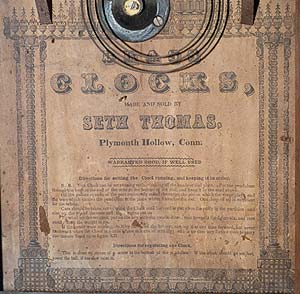
Ogee case, made in Plymouth Hollow, glasses puttied in. Height 25 31/32", width 15 9/16", depth 4 5/16".
Dial: metal, two rings drawn around time track, dots for minute marks.
Early features of dial: tapered numerals 3, 4 and 8, small winding holes (8.2 mm).
Label: printed by Elihu Geer, Hartford, Connecticut, no address given. This dates it to 1842 - 1845.
Movement: missing, the clock had an electric movement when I bought it!
It is interesting that the earliest dials on the Seth Thomas one day brass clock were painted metal. Why did wooden dials appear for a short time around 1845? It may be that they were left over stock from the wooden movement clocks, which were discontinued in 1844 or 1845. This is the theory that Richard Tjarks and I have come up with, please if you can provide any information about this. If you have a Seth Thomas wooden movement ogee clock, so we can compare the dials and case
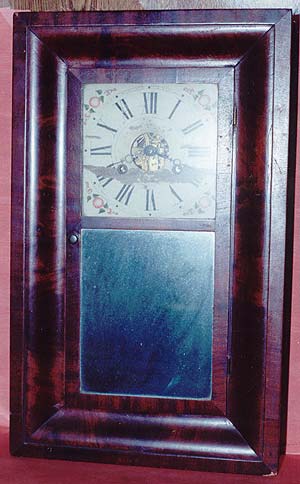
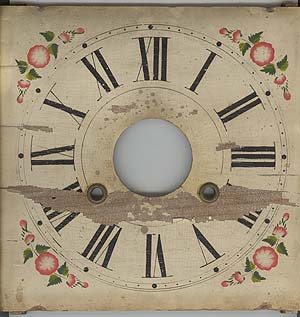
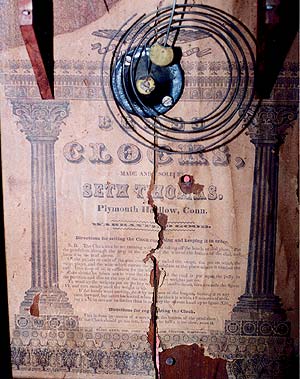
Ogee case, original mirror lower glass, made in Plymouth Hollow, glasses puttied in. Height 26 3/32" - 26 1/16", width 15 5/8", depth 4 5/16".
Dial: wood, two rings drawn around time track, dots for minute marks.
Label: printed by Elihu Geer, Hartford, Connecticut, no address given. This dates it to 1842 - 1845.
Movement: type 1.241, early.
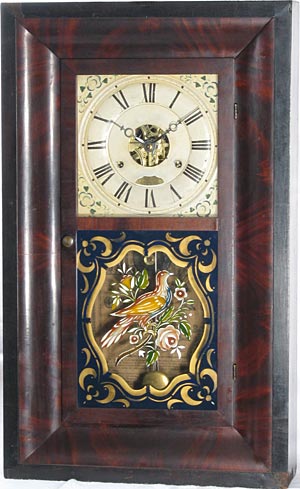
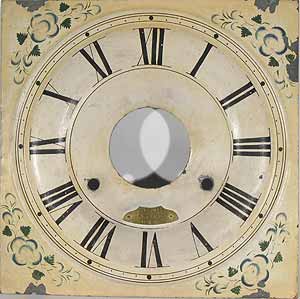

Ogee case, replacement lower glass (painted for me by Lee Davis), made in Plymouth Hollow, glasses held with wood strips. Height 26", width 15 11/16", depth 4 5/16".
Dial: metal, two rings drawn around time track, dots for minute marks.
Early features of dial: tapered numerals 3, 4 and 8, small winding holes (8.2 mm).
Unusual feature of dial: brass nameplate with S. THOMAS PLYMOUTH CONN U S A
Label: printed by Elihu Geer, Hartford, Connecticut, no address given. This dates it to 1842 - 1845.
Movement: type 1.241, early.
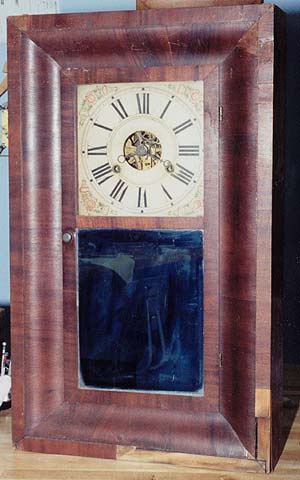
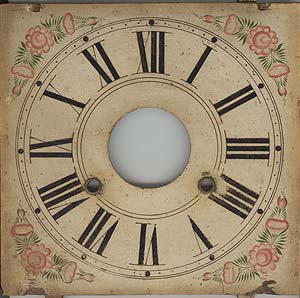
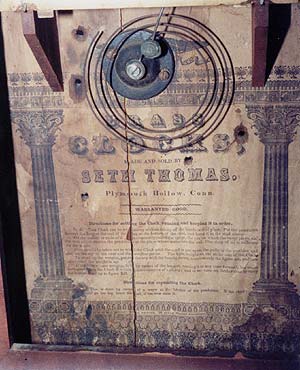
Ogee case, replacement mirror (but it originally had a mirror), made in Plymouth Hollow, glasses held with wood strips. Height 25 15/16" - 26", width 15 9/16", depth 4 5/16".
Dial: wood, two rings drawn around time track, dots for minute marks. (Has unusual feature of two rings drawn around the center opening.)
Label: printed by Elihu Geer, Hartford, Connecticut, 26 State Street. This dates it to 1845 - 1846.
Movement: 1.241, middle, zinc hammer.
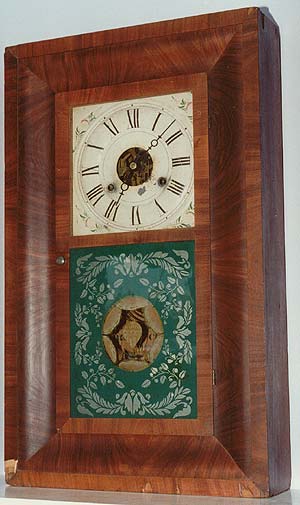
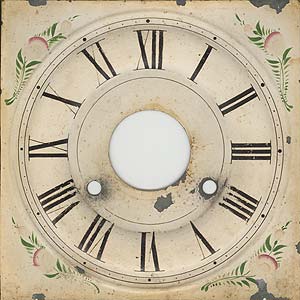
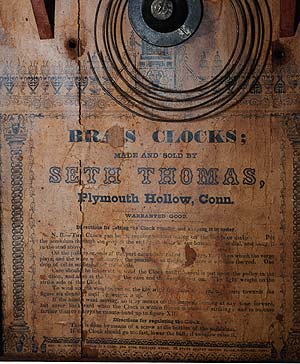
Ogee case, made in Plymouth Hollow, glasses held with wood strips. Height 25 31/32", width 15 9/16", depth 4 1/4".
Dial: metal, one ring drawn around minute marks, dots for minute marks. Winding holes 9.8 - 10 mm diameter.
Label: printed by printed by Geo D. Jewett's Steam Job Card, and Book Printing House, 26 State Street Second Floor, Hartford, Conn. Probable date 1852.
Movement: 1.242 middle, brass hammer.
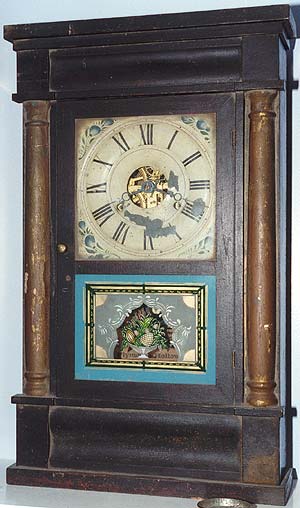
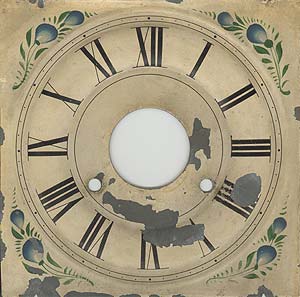
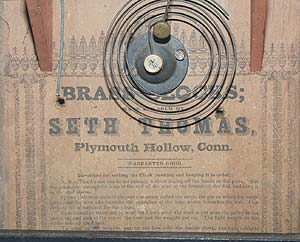
Half column case type one, made in Plymouth Hollow, glasses held with wood strip. Tablet is a reproduction of the original (the original has all the paint missing, but a faint outline of the pattern was visible in the glass). Height 24 15/16".
Dial: metal, one ring drawn around minute marks, dots for minute marks. Winding holes 9.3 mm diameter.
Label: Steam Press of Elihu Geer, No. 10 State Street, First Story, Hartford, Conn. Date 1850 - 55.
Movement: 1.241 middle, brass hammer.
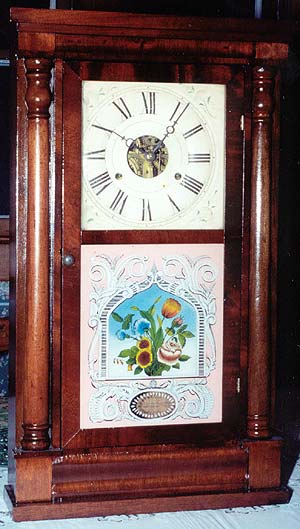
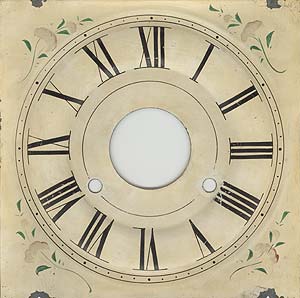
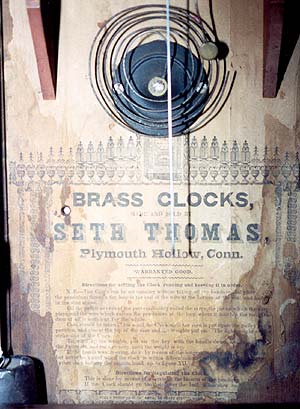
Half column case type two, made in Plymouth Hollow, glasses held with wood strips. Height 25 7/8".
Dial: metal, one ring drawn around minute marks, dots for minute marks. Winding holes about 9.5 mm in diameter.
Label: Steam Press of Elihu Geer, 16 State Street, Hartford, Conn,
Movement: 1.241 middle, brass hammer.
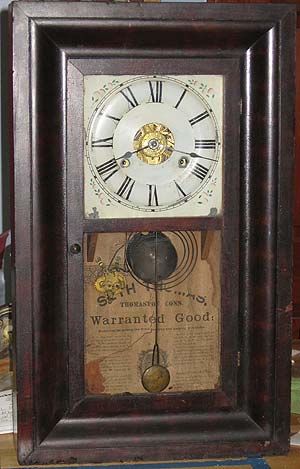
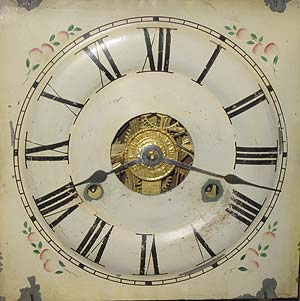
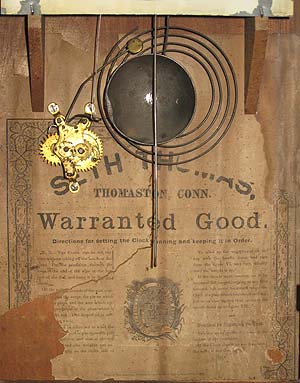
OG case, Thomaston label, Plymouth movement. Height: 25 1/8 inches, width: 15 1/4 inches, Depth: 4 1/16 inches. Tablet opening 7 11/16 by 9 1/8 inches. Tablet size 8 x 9.5 inches (the earlier, taller cases use a 8 by 10 inch glass tablet).
Dial: metal, lines for minute marks, has painted corner decorations. Spade hands.
Label: Printed by American Printing Co., Bank Street, Waterbury, Conn.
Movement: Plymouth, type 1.242 with pillar screws.
Pendulum bob weight: 1.4 ounces; Bob diameter: 1 5/8 inches; Length of bob wire: 3 1/4 inches. Dial minute track: 7 3/8 inches outside diameter; Minute hand length: 3 5/8 inches;
Strike weight: 2 pounds 9 ounces, height: 8.5 cm; top diameter: 46.2 mm; bottom diameter: 57.3 mm.
Time weight: 2 pounds 15 ounces; height: 8.9 cm; top diameter: 46.9 mm; bottom diameter: 59.1 mm.
Case back has stamp of R. L. Higginbotham, Delphi, Indiana.
*"History of the American Clock Business for the Past Sixty Years and Life of Chauncey Jerome, written by himself", pp. 56 - 58, published by F. C. Dayton, Jr, 1860, reprinted 1983 by the American Clock and Watch Museum, ISBN 0-930476-14-X.
**"Illustrated Catalog of Seth Thomas Clocks, Regulators and Time Pieces, 1863", pp. 62 - 63, reprinted by the American Clock and Watch Museum, 1977, with Seth Thomas history by Chris Bailey, ISBN 0-930476-00-X.
"Dating Seth Thomas Clocks" by Paul Heffner, contained on pp. 23 - 24 of "Seth Thomas Clocks & Movements", Tran Duy Ly, U.S. Books, 1996, ISBN 0-964706-0-5.
"Production Dates for Seth Thomas Clocks", Paul V. Heffner, NAWCC Bulletin, Volume 27, No. 4, whole number 237, August 1985, pp. 443 - 4.
"Printers of Hartford, 1825 Thru 1860" by D. R. Slaght.